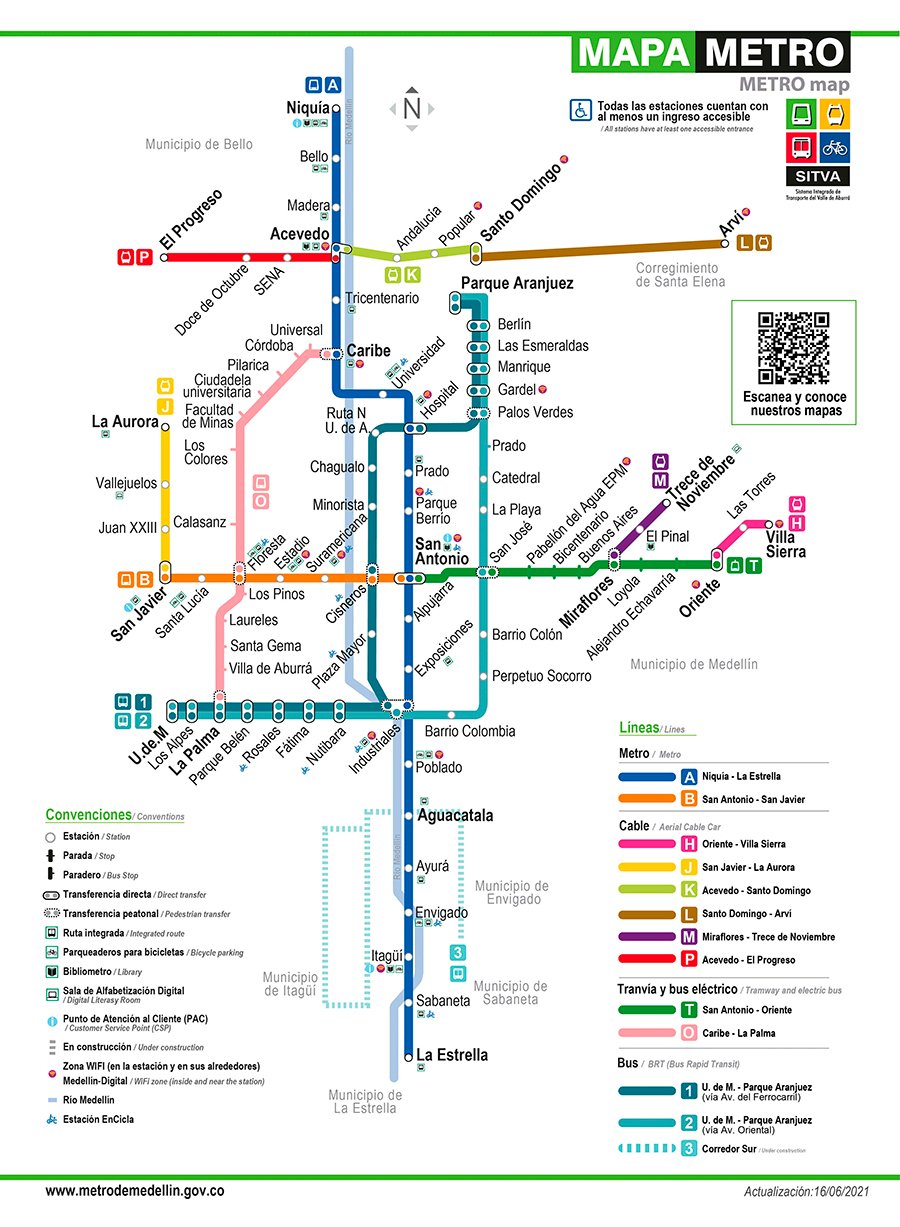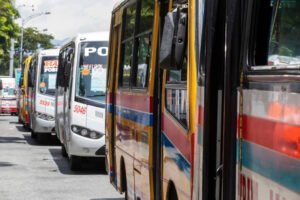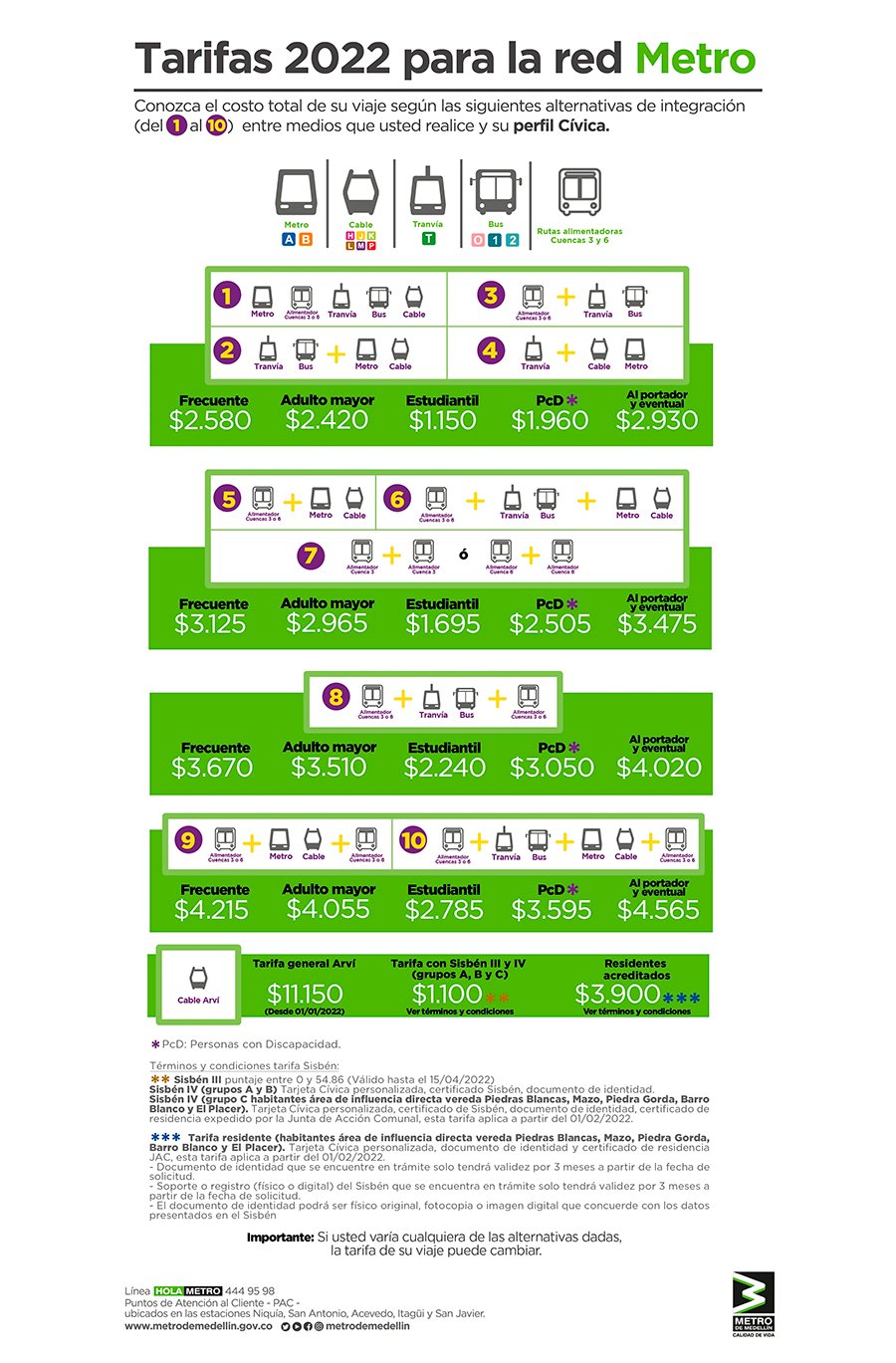As the second biggest city in Colombia, Medellin offers many different places to visit and things to see. As you’re planning your stay, you’ll surely recognize the need to find an efficient and safe way to move around the city. Although taxis are always readily available, Medellin has an amazing public transportation system; the best in the whole country! The system is complex and includes routes all over the city, meaning you shouldn’t have any problem getting anywhere you need to be.
The only problem that some travelers face is that they don’t know how the system works. Although it’s organized and well maintained, it’s understandable why it can be intimidating for people who have never used it before. That’s why we’ve put together a guide so that everyone can take advantage of Medellin’s public transportation.
Medellin Metro Station Map

image source: https://www.metrodemedellin.gov.co/viaje-con-nosotros/mapas
Medellin Public Transportation
Medellin’s public transportation is one of the factors that helped transform the city. Not only does Medellin spread for miles and miles long, but the city is also built into the side of the Andes Mountains. When you see how far Medellin really stretches, you’ll better understand why the transportation system has made a big impact on the quality of life for many locals. It has aided in the development of the city because it connects people in hard-to-reach areas with new opportunities.
This system includes metro rail lines, metrocable car lines, metroplus bus lines, one Tranvia tramcar line, and hundreds of city buses.
Metro Rail Lines

The Metro is the only rail-based mass transportation system in Colombia. It has two rail lines: Line A runs North to South (Niquia to La Estrella), while Line B runs East to West (San Antonio to San Javier). As any other public transportation, you should expect the metro to be busy during rush hours. That said, their system is still more time efficient than taking a bus or taxi thanks to its ability to pass through traffic and arrive at their destination quickly.
Metrocable

This system has 6 metro cable lines: Line H, Line J, Line K, Line L, Line M, and Line P. These cable cars play an important role in the transformation of the city because they connect the outer parts of the city to the center. Without these cable cars, many locals would spend hours getting to the center of Medellin. They are also used for tourism, as they have a route to Parque Arvi, one of the big attractions in Medellin, but they are primarily used as an affordable way to integrate people living in the outskirts of the city.
Metroplus Bus Lines

The Metroplus bus line is essentially a bus, but the difference is that its system is built around the two Metro lines. This helps connect the city and make it cheaper to travel; when you pay for one of the Metro systems, such as the Metro rail line, there is only a small additional fee to change to a different line of transportation.
Tranvia / Electric Bus

The Tranvia is a tram located in downtown Medellin and operates from Downtown at the San Antonio Station to the Oriente Station and from Caribe to La Palma. Similar to Metroplus, it is connected to other forms of transportation, such as the metro rail line and only has a small additional fee when used together.
City Bus

The city bus has routes all over the city, from the center of the city to remote areas. The difference between regular buses and Metroplus bus lines is that city buses are not part of the Metro system, meaning their routes and prices were not created to connect with the whole metro system. That said, there are an abundance of routes and buses available, making them a great option.
Civica Card

The civica card in Medellin is a rechargeable card that is used on the Metro system. It’s free to obtain your card; all you have to do is go to the “punto de atención al cliente (PAC)” booth, which is the customer service booth that is available at the San Antonio, Niquía, San Javier, or Itaguí station and requires some form of identification. Once you obtain your card, you have to recharge it with the desired amount of money. Some people put in enough money for the week, while others recharge it for the whole month; it’s up to the card owner.
As mentioned, the metro system is all connected, meaning the civica card can be used on all types of transportation (aside from city buses). Although it’s not required, this card offers cheaper fares and saves you time. Those who don’t have the civica card must purchase one-time tickets every time they want to use the Metro system. Although there’s nothing wrong with this, it means that they have to wait in line to buy their ticket every time they use the Metro system.
Prices
Here is an updated list of the prices you can expect on Medellin’s Metro system. Riders are grouped into 6 different categories: frecuente, adulto mayor, estudiantil, PcD, Al portador, and eventual.
- Frecuente: For users who use the Personal Civic Card frequently but who do not meet the conditions to be classified as a Preferential User (student, senior or PcD).
- Adulto mayor: For users 60 years of age and older.
- Estudiantil: This is for the student population.
- PcD (people with disabilities): This is for users with permanent or temporary disabilities.
- Al portador: This is a one-use ticket that is purchased at the ticket office and charged with the value of a single Carrier fare trip ($2,280).
- Eventual: This was designed for tourists and sporadic passengers. The Eventual Civic is a card that is owned by the passenger, meaning it allows you to recharge the balance when required; to obtain it you must pay a one-time payment of 6,000 pesos per card.

image source: https://www.metrodemedellin.gov.co/viaje-con-nosotros/tarifas
Bottom Line
The Metro system in Medellin has driven economic and social change for many people in the city. It’s a symbol of the transformation that the city has undergone and should be celebrated for the opportunities that it has offered many locals. When tourists experience the Metro system, they don’t only have access to an affordable and reliable transportation system, but they also have a better understanding of the culture in Medellin.
Soon we’ll be providing more in-depth information about the Metro, such as specific stations and their surroundings and which routes lead to important points of interest for tourists and locals.